Water Flow Data Steers Spring's Recovery
Clearer Views
Since the 1870s, the crystal clear waters of Silver Springs have provided millions of visitors a glimpse into primeval Florida, a world of buried caverns, bubbling springs and cruising alligators, manatees, and long-nosed gar.
Florida’s oldest tourist attraction, Silver Springs is one of the largest artesian springs ever discovered.
But the once-pristine springs and the Silver River that flows from them are threatened by Florida’s growing population. Spring flows have declined due to a combination of climate change, surface drainage alterations, and groundwater pumping. High levels of nitrates and other nutrients flow into the aquifer from lawns, farms, septic systems, faulty sewers, and urban runoff—background concentrations of nitrates in the river jumped 20-fold, from 0.05 mg/l to 1 mg/l, during a 50-year study.
>> Download copy of Mission: Water Magazine
>> Download copy of the Article Only
Invasive plants, including hydrilla, have upset the ecological balance of the plant community. And algae, fueled by nutrient-enriched flows, coat native eelgrass, and floats on the water’s surface, dulling the system’s sapphire glow.
Mitch Wainwright, hydrographer for the St. Johns River Water Management District (SJRWMD) in Palatka, Florida, grew up visiting Silver Springs. Now he is collecting data that will help inform restoration efforts for the springs.
“As a kid in the early ‘60s, I remember how clear it was,” Wainwright says. “I’ve seen a difference in my lifetime. It’s amazing.”
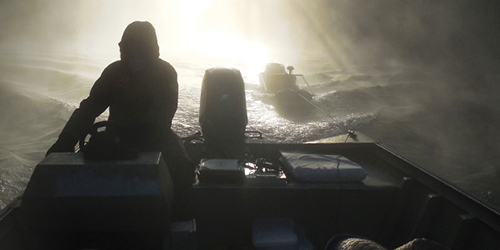
Sunrise - Silver Springs, Florida. Towing a SonTek HydroSurveyor for flow data. Photo: SJRWMD
Mysterious Foundations
Silver Springs—a network of two dozen or more springs in central Florida—bubble up through central Florida’s Karst formations, limestone beds that have been carved by acidic groundwater and rain into baroque networks of caves, channels, domes and tunnels. Channels in the matrix flow with underground rivers and provide quick conduits between surface water and shallow groundwater. As domes collapse and sinkholes form, ancient paths are rerouted beneath the surface.
That makes flow studies incredibly complex, and makes the once-pristine Silver Springs and Silver River system highly sensitive to pollution.
“The Karst geology is a great transporter of water from surrounding areas,” says Mitch Wainwright, hydrographer for the St. Johns River Water Management District. “The underground ‘rivers’ efficiently move water throughout the aquifer. Rainfall is a constant contributor, but it also has the effect of washing nutrients and other pollutants into the upper Floridian aquifer.”
In fact, that effect can take place much more quickly than scientists once assumed. Wainwright describes a dye test in the aquifer near Silver Springs to track the travel time of a marked sample of water through the system.
“It’s really quite amazing—they were expecting it to take six months, but it got there in two weeks,” he says. “It can move a lot faster than we thought.”
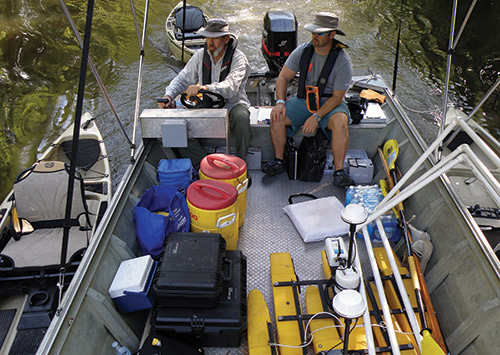
Hydrographers with the SJRWMD geared up quarterly for an extensive study of a six-mile reach of Florida's Silver River.
Go with the Flow
Wainwright’s exploration of the springs goes far beyond childhood memories and casual observation. Over the past two years, he has carefully measured velocity and flow quarterly in a six-mile stretch of the Silver River, which connects Silver Springs to the Ocklawaha River. Those measurements comprise a database of flow and vegetation characteristics that will help scientists understand the dynamics of the river and build a model to predict its behavior.
One of the biggest challenges in collecting data, he says, is the thick, submerged aquatic vegetation—some natural, some invasive—that grows in the river and can alter water movement.
“The vegetation can be a couple of inches to four or five feet high,” Wainwright notes. “It changes by the season, but there are times when it gets so thick you can’t paddle through it. It can alter the velocity pattern and changes based on where the velocity is in the channel.”
Several years ago, during an extremely hot summer, the river surface was completely covered with vegetation. Wainwright and his colleagues were not able to document whether the thick mats of plants had dammed the river’s flow that season, but the situation alerted them to the need for an in-depth study of the physics and biology of the river.
The timing was perfect: the SJRWMD was launching a comprehensive springs research effort with the University of Florida, and the State of Florida initiated significant funding to help implement restoration projects. Understanding the vegetation dynamics would be a critical step.
“The aquatic vegetation is a very good indicator of water quality,” Wainwright says. “Seasonal changes are important due to the variation of sunlight and discharge patterns.” Submerged aquatic vegetation does more than alter water flow—it also interferes with Wainwright’s ability to measure flow and velocity all the way to the bottom of the river. “Basically, we’re getting a picture of the top of the canopy,” he explains.
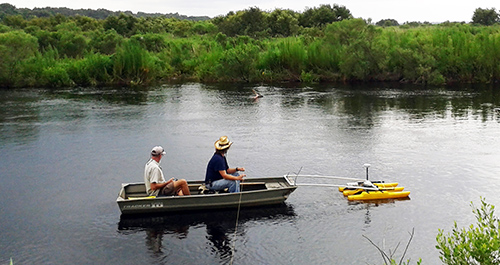
Florida's spring-fed rivers are home to a host of wildlife species, including alligators...adding urgency and a bit of excitement to data collection. Photo: SJRWMD
Comparing canopy depth data with true-bottom readings by divers and surveyors along four lateral transects in the river, analysts will be able to calculate the waxing and waning of the submerged vegetation from season to season. GPS pinpointed permanent markers hammered into the riverbed provide fixed references for river bottom reading sites, with surveys providing bed angles and the slope of the bank. They also guide the divers and kayak-paddling hydrographers along the transect paths.
In total, Wainwright conducts 11 transects across the Silver River every three months to profile flow, velocity, and canopy depth using RiverSurveyor M9 systems produced by SonTek, a Xylem brand. The RiverSurveyor systems are equipped with a hydroboard floating platform and a power and communications module that includes an integrated GPS system.
Wainwright and his team from the district also conduct 12 longitudinal transects every quarter, profiling flow, velocity, direction, and canopy depth along a six-mile reach. The district uses four RiverSurveyors in the massive data-gathering effort. Wainwright designed a lightweight PVC frame that attaches to each RiverSurveyor’s hydroboard on one end and a kayak on the other, which allows a hydrographer to steer the instrument without interfering with how it floats.
User-Friendly Instruments
Wainwright says the RiverSurveyor M9—which uses nine transducers and multiple acoustic frequencies to measure flow and velocity at depths of a few centimeters to 40 meters—is ideally suited for the complex bathymetry and dense aquatic forests that make the Silver River a challenging place to profile.
“The RiverSurveyor has been extremely reliable during all conditions,” he says. “I was especially amazed to see the integrated GPS system pick up numerous satellites through heavy tree canopies during the summer season.
With its multiple acoustic frequencies, the system will switch from measuring in shallow water to deep water automatically, and it autoconfigures in the field. Calibration takes five minutes—it’s a simple self-test.
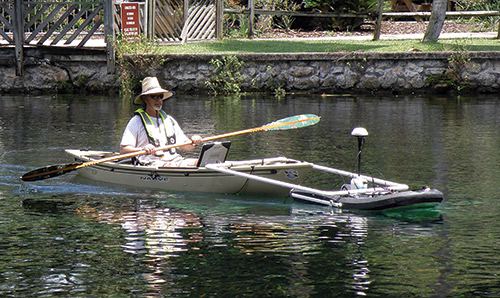
Mitch Wainwright of the SJRWMD figures he paddled more than 200 to 300 miles while measuring depth, flow and velocity of a six-mile reach of the Silver River in 2015 and 2016. Photo: SJRWMD
SonTek product manager, Isaac Jones, says Wainwright and the SJRWMD team have tapped into the versatility and performance features of the RiverSurveyor M9 in a cluttered, complex environment.
“Mitch and his colleagues provide an amazingly detailed look at the characteristics of the channel—dominated by vegetation, logs and a maze of cypress tree roots and their impacts on flow through the river,” Jones says. “They have harnessed the capabilities of the RiverSurveyor’s SmartPulse system to automatically select the optimum frequency, ping rate and processing techniques to provide valuable data as the river’s depth and velocity change in a very challenging application. Working in a heavily vegetated environment, they rely heavily on the RiverSurveyor telemetry and GPS package."
“The tool works well, but nothing works perfectly in an environment like this,” Jones adds. “Mitch and his team have overcome many obstacles through hard work, creativity, ingenuity and collaboration with other experts. The insight they are providing on flow and detailed channel bottom features will complement the growing understanding of water quality parameters and pollution to provide a deep look into this fascinating environment.”
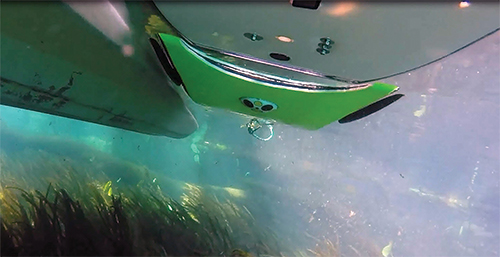
Using four RiverSurveyor M9s, Mitch Wainwright and the SJRWMD team mapped changes in underwater vegetation and river flow every three months for two years, providing insight into the mysterious world of Florida's spring-fed river systems. Photo: SJRWMD
Data Visualization
The immense amount of data collected during the SJRWMD’s quarterly transects was processed through WaterCube, which combines data sets from multiple Acoustic Doppler Current Profilers (ADCPs) and filters the data to yield highly accurate visualizations of the Silver River. Wainwright and his team capture details in cells as small as two centimeters in area and velocity measurements accurate to 0.001 meters per second, providing WaterCube with high-definition (HD) data to create pin-sharp graphics.
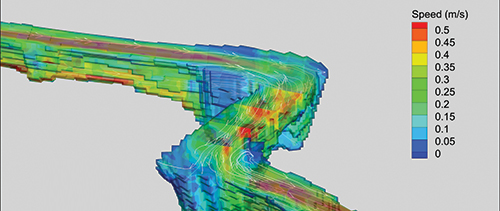
Data from 12 longitudinal and 11 latitudinal transects of the Silver River yields high resolution data that helps hydrographers visualize the contours of the river as well as flow velocity and direction on a 6-mile reach. Courtesy: WaterCube
“WaterCube processing has been a giant plus,” Wainwright says. “They are able to screen out the questionable data that is generated from situations like side lobe interference, GPS multipath from dense tree canopy, and bottom-tracking issues when dealing with subsurface aquatic vegetation. For me to do that manually would take 10 years. And their 3-D and cross-section velocity visualization helps us explore the data set rapidly.”
Ultimately, SJRWMD’s Silver River flow data will form the basis of a hydrodynamic model that will allow scientists to predict the flow of water. That insight will be combined with research currently being conducted by collaborators at the University of Florida on water quality, ecology and aquifer transport to provide a clearer view of the workings of the mysterious, complex and compellingly beautiful world of Florida’s spring-fed rivers.
